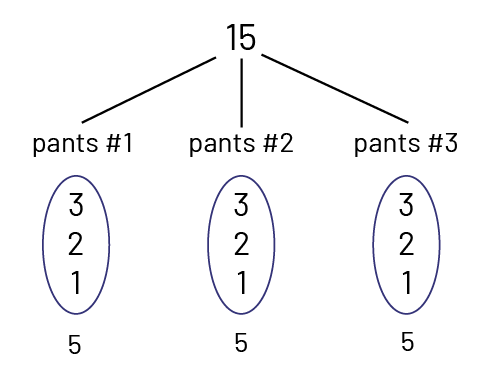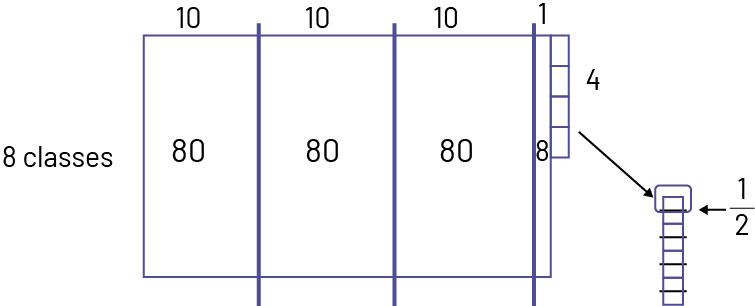B2.6 Represent and solve problems involving the division of two- or three-digit whole numbers by one-digit whole numbers, expressing the remainder as a fraction when appropriate, using appropriate tools, including arrays.
Skill: Solving Problems Involving Division of Two- or Three-Digit Whole Numbers by One-Digit Whole Numbers
Students develop an understanding of multiplication and division and the relationships between numbers by solving problems. The types of problems and examples presented below can support students to see the basic multiplication and division facts in a variety of ways, depending on whether the problems are equal group, multiplicative comparison, or combination problems. Using problems to introduce basic number facts forces students to reason their way to solutions and thus develops a better sense of operations.
Equal-Grouping: Number of Groups Unknown
The school has purchased 150 books for the classrooms and is preparing bins. A parent volunteer puts 30 books in each bin. How many bins did the parent use?

\[150 \div 30 = ? \;{\rm{or}}\; ?\; \times 30 = 150\]
The Array

The parent volunteer used 5 bins for books.
Equal-Sharing: Group Size Unknown
The school purchases 150 books for each of the 5 classes. A parent volunteer prepares 5 bins of books. How many books are in each bin?

\[150 \div 5 = ?\;{\rm{or}}\;5\; \times ? = 150\]
Sharing (Partitive)

\[10 + 10 + 10 = 30\]
Each bin holds 30 books.
Combinations Problem
Combination: Size of Set Unknown
Mustapha has new shirts and pants. He has 15 different outfits in all. If he has three pairs of pants, how many shirts does Mustapha have?
\[15 \div 3 = ?\;{\rm{or}}\;3\; \times ? = 15\]
Equal-Sharing - Tree Diagram

\[15 \div 3 = 5\;{\rm{or}}\;3\; \times 5 = 15\]
Mustapha has 5 shirts.
Source: translated from Guide d'enseignement efficace des mathématiques de la maternelle à la 6e année, Fascicule 5, p. 10-11.
The Concept of Remainder
In a division, the concept of a remainder arises when the quotient is not a whole number. For example, \(10\; \div \;3\; = \;3\) with 1 remainder or \(3 \frac{1}{3}\) . For many students, the remainder is just a number that appears in the "recipe" for division (for example, \(123\; \div \;5\; = \;24\) with a remainder of 3).
However, when the operation arises from a context, the remainder must be considered in order to adequately answer the problem. Thus, students can develop the ability to deal with the remainder if they are in a problem-solving situation.
Source: translated from Guide d'enseignement efficace des mathématiques de la 4e à la 6e année, Numération et sens du nombre, Fascicule 1, Nombres naturels, p. 86.
It is recommended that students have experience with division problems that have a remainder from a young age, since in everyday contexts, division does not always result in a whole number. It is important to introduce these scenarios in a context related to students' experiences, as it is an abstract concept.
Example
- Without Context
\(10\; \div \;3\; = \;3{\rm{R1}}\)
What does R1 represent, a child or a candy?
- With Context
In the following example, the remainder is distributed equally and expressed as a fraction.
Lucas wants to give 10 muffins to his 3 friends. He wants each friend to receive the same amount of muffins. How many muffins does he give to each of his 3 friends?

In context, it is easier to determine what the R1 represents. Here, it is a muffin.
Each child will have \(3\; + \;\frac{1}{3}\) muffins or \(3\frac{1}{3}\).
The remainder is expressed as a fraction, since a muffin can be divided.
Source: translated from L'@telier - Ressources pédagogiques en ligne (atelier.on.ca).
Computational Strategies
The following are a variety of strategies that can be used to carry out a division. They answer to a variety of needs and facilitate student learning.
To make this section easier to read and understand, the operations are presented as numerical expressions and models. In the classroom, teachers should also represent the computations horizontally, for example: \(432 \div 5\).
When faced with a division to be carried out, either one looks for the number of groups - quotative division - or one looks for the size of each group - partitive division. Thus, computational strategies may differ depending on the type of division. Students should have the opportunity to learn and use multiple strategies to solve division problems of both types.
As with other operations, students may initially use manipulatives.
Source: translated from Guide d'enseignement efficace des mathématiques de la 4e à la 6e année, Numération et sens du nombre, Fascicule 1, Nombres naturels, p. 121, 140-145.
Example 1
Mrs. Langlois has 125 stickers. Every day, she gives 5 stickers to students. After how many days will Mrs. Langlois have given all her stickers?
\[125 \div 5 = ?\]
Estimation
\(\begin{array}{c}125 \div 5 \approx 100 \div 5\\ \approx 20\end{array}\)
Strategy 1
Division Using an Array
I decomposed 125 into \(100\; + \;25\), which are 2 multiples of 5. This makes division easier.
I first divided 100 by 5 and then 25 by 5. I added the two quotients to get the number of days it took for Mrs. Langlois to give away all her stickers.

\(20\; + \;5\; = \;25\)
I can conclude that Mrs. Langlois will be able to give out stickers for 25 days.
Strategy 2
Division Using a Number Line
“I drew a number line from 0 to 130, in increments of 10. I made a hop from 0 to 100, which is 10 tens. Since every ten has 2 fives, that’s a total of 20 fives. I made another hop from 100 to 125, which is 25, or 5 fives. So in all there are 20 + 5 = 25.

\(\begin{array}{l}100 \div 5 = 20\\25 \div 5 = 5\\20 + 5 = 25\end{array}\)
I can conclude that Mrs. Langlois will be able to give out stickers for 25 days.
Example 2
At Aureste School, the principal buys 252 packages of grid-paper. She divides them equally among 8 classes. How many packages does each class receive?
\[252 \div 8 = ?\]
Estimation
\(\begin{array}{c}252 \div 8 \approx 240 \div 8\approx 30\end{array}\)
I know my answer is about 30 packages.
Strategy 1
Division Using an Array
I decomposed 252 into the multiples of 8 that I know, that is, \(80 + \;80 + \;80\) and I am left with 12.
I knew that \(80\; \div \;8\; = \;10\). There are 12 left. So I could make another group of 8. I had 4 packages remaining. I divided each package into 2 to make 8 half packages.

\(\ 10 + 10 + 10 + 1 + \frac{1}{2} = 31\frac{1}{2}\)
She distributes \(\ 31\frac{1}{2}\) packages to each class.
Source: adapted and translated from Les mathématiques... un peu, beaucoup, à la folie!, Guide pédagogique, Numération et sens du nombre/Mesure, 4e, Module 2, Série 2, Introduction, p. 172.
Strategy 2
Division Using Multiplication
I decomposed 252 into the multiples of 8 that I know, that is, \(80 + \;80; + \;80\) and I am left with 12.
I multiplied \(8 \times 10\), 3 times. I added the partial products to get 240. I subtracted 240 from 252, which gave me 12, so I could take one more 8 away. So I can distribute 10 + 10 + 10 = 31 packages per class and have 4 packages left over.

There are 4 packages left. I can divide each package into 2 to have 8 half-packages.
She then distributes \(31\frac{1}{2}\) packages to each class.
Source: adapted and translated from Les mathématiques... un peu, beaucoup, à la folie, Guide pédagogique, Numération et sens du nombre/Mesure, 4e, Module 2, Série 2, Introduction, p. 172.
Knowledge: Types of Division
There are two types of division problems. The others are derived from multiplication.
The "Equal-Grouping" Division (Measurement or Quotative)
Here we know the total number and the size of each group. We are looking for the number of groups.
The "Equal-Sharing" Division (Partitive)
Here, a set of objects is divided equally among a number of groups or individuals. We know the total number and the number of groups. We look for the number of objects in each group or the size of each group.
